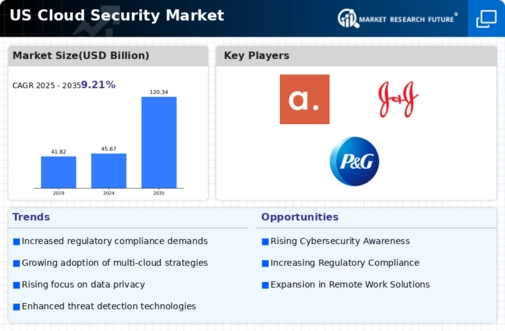Shift to Remote Work Models
The cloud security market is witnessing a transformation driven by the shift to remote work models. As organizations in the US increasingly adopt flexible work arrangements, the reliance on cloud-based services has surged. This transition necessitates enhanced security measures to protect remote access to sensitive data. A report indicates that 70% of companies have accelerated their cloud adoption strategies in response to the remote work trend. Consequently, the demand for cloud security solutions is on the rise, as businesses seek to mitigate risks associated with remote access. This shift not only highlights the importance of securing cloud environments but also presents opportunities for innovative security solutions tailored to remote work scenarios.
Rising Cyber Threat Landscape
The cloud security market is experiencing heightened demand due to an increasingly complex cyber threat landscape. Organizations in the US are facing a surge in cyberattacks, with data breaches and ransomware incidents becoming more prevalent. According to recent statistics, the average cost of a data breach in the US reached approximately $4.24 million in 2023. This alarming trend compels businesses to invest in robust cloud security solutions to safeguard sensitive information. As cybercriminals adopt more sophisticated tactics, the need for advanced security measures becomes paramount. Consequently, the cloud security market is projected to grow significantly, as companies prioritize the protection of their digital assets against evolving threats.
Growing Demand for Data Privacy
The cloud security market is being propelled by the growing demand for data privacy among consumers and businesses alike. In an era where data breaches are commonplace, individuals are increasingly concerned about how their personal information is handled. This concern is reflected in the rising number of privacy regulations being enacted across the US, which require organizations to implement stringent security measures. As a result, businesses are investing in cloud security solutions that prioritize data protection and privacy. The market is likely to see continued growth as companies strive to build trust with their customers by demonstrating a commitment to safeguarding their data.
Regulatory Compliance Pressures
The cloud security market is significantly influenced by the increasing pressures of regulatory compliance. Organizations in the US are required to adhere to various regulations, such as the Health Insurance Portability and Accountability Act (HIPAA) and the General Data Protection Regulation (GDPR). Non-compliance can result in hefty fines, which can reach millions of dollars. As a result, businesses are compelled to implement comprehensive cloud security measures to ensure compliance with these regulations. The market is expected to expand as companies seek solutions that not only protect their data but also facilitate adherence to legal requirements. This trend underscores the critical role of cloud security in maintaining operational integrity and avoiding financial penalties.
Technological Advancements in Security Solutions
The cloud security market is benefiting from rapid technological advancements in security solutions. Innovations such as advanced encryption techniques, multi-factor authentication, and real-time threat detection are becoming integral to cloud security strategies. These technologies enhance the ability of organizations in the US to protect their data from unauthorized access and cyber threats. As businesses increasingly recognize the value of adopting cutting-edge security measures, the market is expected to expand. The integration of artificial intelligence and machine learning into security solutions further enhances their effectiveness, allowing for proactive threat identification and response. This trend indicates a promising future for the cloud security market as organizations seek to leverage technology to bolster their security posture.
















Leave a Comment